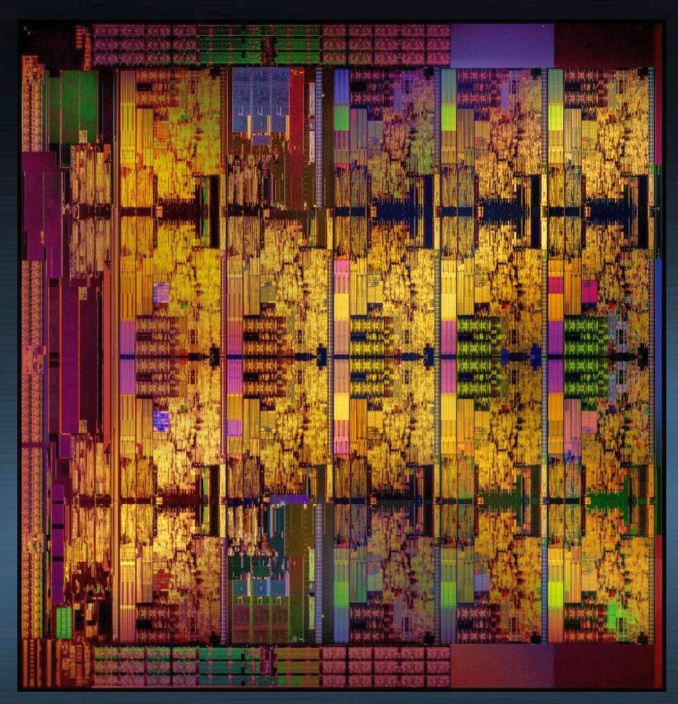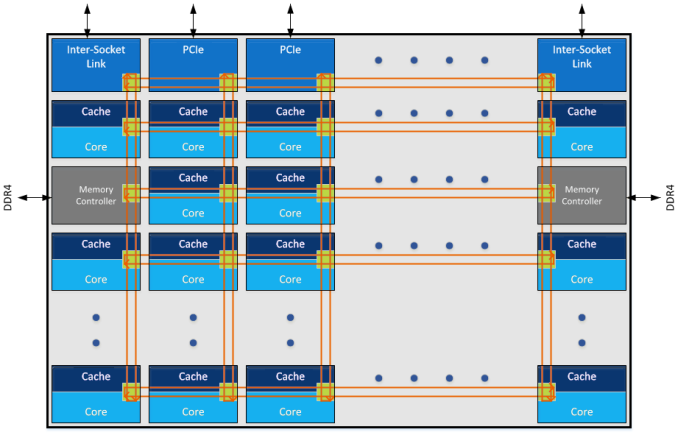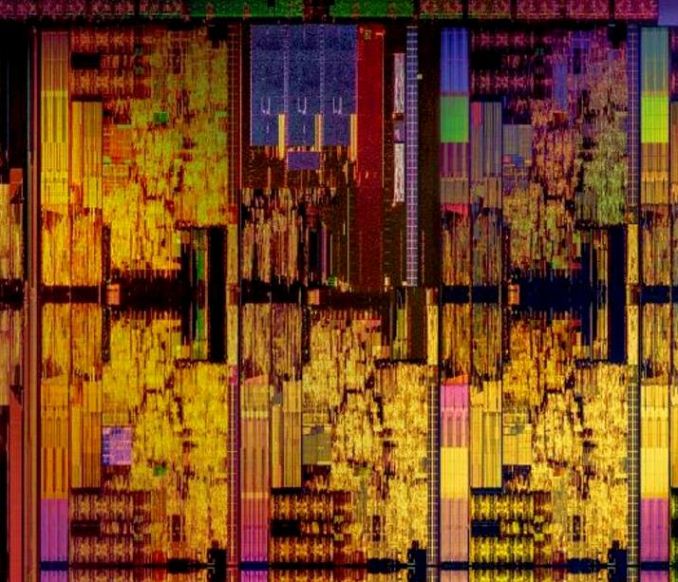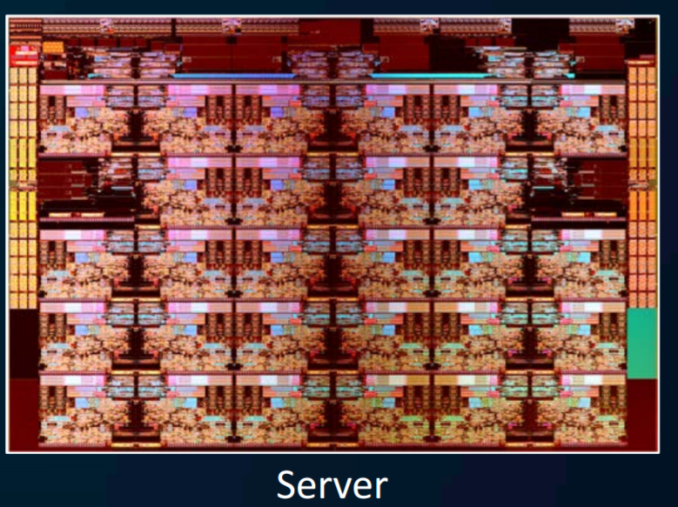The Intel Skylake-X Review: Core i9 7900X, i7 7820X and i7 7800X Tested
by Ian Cutress on June 19, 2017 9:01 AM ESTDie Size Estimates and Arrangements
On the previous page, we showed pictures of ring bus and mesh arrangements. With a ring bus, ultimately the silicon layout of the cores and the interconnects can be regular but are not that stringent. Put the cores in a circle (or overlapping circles) and away you go. With a mesh, things get a little more rigid.
The mesh diagrams on the previous page are all presented as rectangles in x*y arrangements. You either have to add a full row or a full column to increase the die count, whereas in a ring it could be straight forward just to add another pair of cores into the ring (which is what happened over the last few generations). Adding a pair of cores in a mesh means that you end up with more corners and more edges – not all cores end up ‘equal’ and there can be performance penalties therein. Ideally, an arrangement where x = y is usually the best bet. This lets us make some predictions about how Intel’s silicon is lining up.
A side-note for discussion. If we had a 100x100 core arrangement, the cores in the middle would have big latency to get anywhere near external memory. Also, a 2D mesh could become a 3D mesh.
Three things come to our aid in discussing the LCC and HCC silicon. First was the original Skylake-X announcement back at Computex: one of Intel’s slides had an image of the basic floorplan of the HCC silicon to be used for the high core-count Skylake-X processors:
At the time, we were a bit stumped by this image. By counting the regular structures, we can see 4x5 arrangement, or rather a 20-core chip. On closer inspection two of the cores were different: on the second column, the top and bottom ‘cores’ did not look like cores. At the time we postulated that given the size of AVX512, this might be where they were. But the second piece of information was given through Intel’s mesh announcement.
Here’s the diagram:
This is meant to be a pseudo mockup of a theoretical core of n processors using the mesh topology. At the top are the socket links, along with the PCIe root complexes. However on the left and right are the DRAM controllers, essentially taking up the same area as a core but also using one of the mesh networking links.
So scoot back to that HCC die image, and zoom in on one of those odd looking ‘cores’:
What we can see is three regular blue/green vertical areas, which means three on each side, for a total of six. Skylake-X only has four memory channels, but leaks have shown that the new Skylake-SP processors have six memory channels by design, so here they are. In the 4x5 grid, we have 18 cores and two sets of memory channels.
Back when Skylake-X was announced at Computex, I wrote that we were expecting the LCC silicon to be a 12-core design. At this time, we were still expecting Intel to use a ring-bus topology, and I mentioned before, adding two cores to a ring bus is fairly easy at the expense of peak latency between cores. Now that we know that Intel is using a mesh, it is quite different.
12 cores could quite easily fit into LCC silicon in a 3x4 arrangement, but that does not leave any room for the six memory controllers that the enterprise Xeons are all meant to have. If we added two ‘extra’ core sized areas for the 12-core design, we need a total of 14 segments. Using the x*y arrangement as required above, the only way 14 cores works is using a 7*2 arrangement. If this was the case, the DRAM controllers would essentially fill a whole row, or be at opposite ends of the column. If one of the x*y numbers is the number two, it makes more sense to use a ring bus any day of the week for power, die area and simplicity.
So that means that the 12-core SKU, the Core i9-7920X, is likely derived from the HCC 18-core silicon. Which also explains why that CPU has been delayed until August.
Die Sizes
At this point in time, the Skylake-X processors based on the LCC silicon have been in the hands of a few people. At Computex there were several extreme overclocking (using sub-zero coolants) events dedicated to the new processors. One element of recent extreme overclocking is delidding the processor and removing the integrated heat spreader to replace the thermal interface material underneath.
In general removing the IHS is not recommended without practice and experience, but for some processors in the past we have seen sizeable temperature benefits by replacing the standard thermal interface material (TIM) that Intel uses. The discussion on whether Intel should be offering a standard goopy TIM or the indium-tin solder that they used to (and AMD uses) is one I’ve run on AnandTech before, but there’s a really good guide from Roman Hartung, who overclocks by the name der8auer. I’m trying to get him to agree to post it on AnandTech with SKL-X updates so we can discuss it here, but it really is some nice research. You can find the guide over at http://overclocking.guide.
However removing the IHS means we can measure the silicon die.
The 10-core LCC die, which is a 3x4 design, measures in at 14.3 x 22.4, or 322mm2.
Using this, working from Intel’s 4x5 HCC diagram (and assuming it hasn’t been stretched), we can get 21.6 x 22.4 = 484mm2 for the high-core count design.
That leaves the Extreme core count option. Using the x*y strategy again, Intel could either run a 5x5 design, which gives 25 areas and 23 cores – which is unlikely. Next up is a 5x6 design, which gives 30 areas and 28 cores. It’s no secret that many leaks are pointing to a 28-core XCC processor at this point.
There’s also the fact that Intel provided this die shot at the Intel Manufacturing Day a few weeks ago, clearly showing the 5x6 arrangement:
Doing the basic math on a 5x6 design gives us a 21.6 x 32.3 = 698mm2 die size for XCC.
| Skylake-SP Die Sizes | |||
| Arrangement | Dimensions (mm) |
Die Area (mm2) |
|
| LCC | 3x4 (10-core) | 14.3 x 22.4 | 322 mm2 |
| HCC | 4x5 (18-core) | 21.6 x 22.4 | 484 mm2 |
| XCC | 5x6 (28-core) | 21.6 x 32.3 | 698 mm2 |
Compared to other chips with Intel’s mesh architecture, Knights Landing comes in at 646mm2 (minus MCDRAM), and sources put Knights Corner at 720mm2.














264 Comments
View All Comments
FreckledTrout - Monday, June 19, 2017 - link
Missing the 7820x on the power draw graph.Ian Cutress - Tuesday, June 20, 2017 - link
The 7820X power numbers didn't look right when we tested it. I'm now on the road for two weeks, so we'll update the numbers when I get back.chrysrobyn - Monday, June 19, 2017 - link
In my head I'm still doing the math on every benchmark and dividing by watts and seeing Zen looking very different.Old_Fogie_Late_Bloomer - Monday, June 19, 2017 - link
I'm sure I'm wrong about this, but it makes more sense to me that the i9-7900X would be a (significantly) cut down HCC die instead of a perfect LCC. i9 vs i7, 44 vs 28 lanes, two AVX units instead of one?And yet the one source I've found so far says it's the smaller die. It's definitely the LCC die, then?
Ian Cutress - Tuesday, June 20, 2017 - link
HCC isn't ready, basically. LCC is. Plus, having a 10C LCC die and not posting a top SKU would be wasteful of the smallest die of the set.Also, delidding a 10C SKU.
Old_Fogie_Late_Bloomer - Tuesday, June 20, 2017 - link
Well, it wouldn't be a waste if Intel's yields weren't good enough to get fully functional dies. The fact that Intel is not just releasing fully functional LCC chips but announced that they would be the first ones available suggests that they have no trouble reliably producing them, which is pretty impressive (though they have had plenty of practice on this process by now).Thanks for the response; I thoroughly enjoyed the review and look forward to further coverage. Exciting times!
Despoiler - Monday, June 19, 2017 - link
Considering Ryzen is in the desktop category and these Intel chips are HEDT, we need to wait to see what Threadripper brings. AMD won't have the clock advantage, but for multithreaded workloads I suspect they will have more cores at a cheaper price than Intel.FreckledTrout - Monday, June 19, 2017 - link
I wouldn't say AMD wont have a clock advantage once you get to the 14 and 16 core chips. They might not but you saw the power numbers and thermals, Intel very well may have to pull back the frequency as they scale up the cores more than AMD will.FMinus - Thursday, June 22, 2017 - link
Actually I think it's the other way around. AMD might have clock advantage on higher core models thanks to not going with the monolithic approach. Easier to to cool those beasts but power is still an issue.If you imagine four 1800x on one interposer, you can see them reaching 4GHz on all of those dies, that said the power consumption would be massive, but easier cooler as the intel 16 core variant.
Lolimaster - Tuesday, June 20, 2017 - link
The 1995X will have a stock 3.6Ghz for the 16cores, same as the 7900X with just 10.